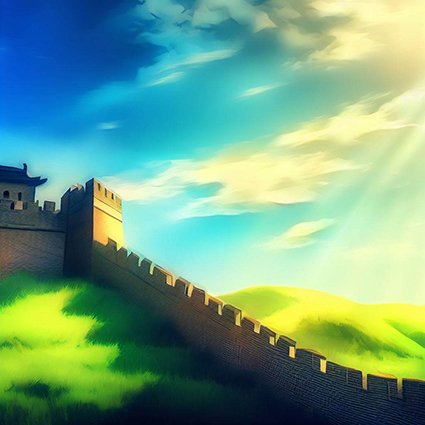20 Fun Facts about the Great Wall of China
The Great Wall of China is an architectural marvel and a testament to the ingenuity and perseverance of human beings. This historic structure spans across thousands of miles and has protected the Chinese civilization from invaders for centuries.
Here are 20 fun facts about the Great Wall of China
1. Ancient origins: The Great Wall of China's construction began in the 7th century BC, during the Warring States period. Over time, the wall has been built, rebuilt, and expanded by various dynasties, with the most famous sections being erected during the Ming Dynasty (1368-1644 AD).
2. A labor of love: It's estimated that over 1 million laborers contributed to the building of the Great Wall, including soldiers, convicts, and ordinary citizens. Their hard work and dedication have left a lasting legacy.
3. Multiple materials: The Great Wall is not made from a single material. It was built using a variety of materials, including earth, wood, bricks, and stone. The choice of material depended on the local resources available, which has resulted in a diverse and visually striking structure.
4. Unifying force: The Great Wall was initially constructed as separate walls by different states. It was Emperor Qin Shi Huang, the first emperor of a unified China, who connected these walls, creating the unified Great Wall we know today.
5. Impressive length: The Great Wall of China stretches over an astonishing 13,170 miles (21,196 kilometers). To put that into perspective, it's almost half the circumference of Earth!
6. Varying heights: The height of the Great Wall differs along its path. In some places, it is as low as 16 feet (5 meters), while in other areas, it can tower up to 26 feet (8 meters).
7. Width matters: The wall's width also varies depending on the section. On average, it measures 16-19 feet (5-6 meters) at the base and 9-12 feet (3-4 meters) at the top, wide enough for soldiers and horses to patrol comfortably.
8. Ingenious design: The Great Wall features watchtowers, beacon towers, and barracks strategically placed along its length. These structures allowed for efficient communication and troop mobilization, ensuring the wall's effectiveness in defense.
9. Cultural significance: The Great Wall of China is a symbol of national pride and a representation of the country's rich history. It has inspired countless works of art, literature, and poetry throughout the ages.
10. Biodiversity preservation: The Great Wall has inadvertently helped protect the biodiversity in certain areas by acting as a natural barrier against human encroachment. Some endangered species, like the North China leopard, have found a safe haven around the wall, and many unique plant species thrive in these undisturbed areas.
11. World Heritage status: The Great Wall was designated as a UNESCO World Heritage Site in 1987, recognizing its historical, cultural, and architectural significance. This title has helped promote its conservation and appreciation worldwide.
12. Myths debunked: Contrary to popular belief, the Great Wall of China is not visible from the moon with the naked eye. This myth has persisted over time, but astronauts and space imagery have disproven it.
13. Forbidden passage: Though the Great Wall was built to protect China from invaders, it was also used to control the movement of goods and people within the country, helping regulate trade and taxation.
14. Great Wall marathon: Talk about an energetic way to experience the Great Wall! Every year, the Great Wall Marathon takes place, offering runners an unforgettable race along the iconic structure, complete with challenging ascents, descents, and breathtaking views.
15. Great Wall graffiti: Over the years, some visitors have left their mark on the Great Wall by carving their names or messages into the bricks. Today, graffiti is strictly forbidden to protect and preserve this historical treasure.
16. Conservation efforts: The Chinese government, along with local and international organizations, is working diligently to preserve the Great Wall. Restoration projects are ongoing, and stricter regulations have been implemented to protect the wall from further damage.
17. Sustainable tourism: Efforts are being made to promote sustainable tourism at the Great Wall, which includes limiting visitor numbers, providing eco-friendly facilities, and educating tourists about the importance of conservation.
18. Virtual exploration: As technology advances, virtual and augmented reality experiences are being developed to allow people worldwide to explore the Great Wall without physically visiting it. This not only helps promote the site but also reduces the environmental impact of tourism.
19. A symbol of unity: The Great Wall continues to serve as a symbol of unity and perseverance, inspiring people across the globe to come together for common goals and shared achievements.
20. The power of human endeavor: The Great Wall of China stands as a testament to the incredible feats humans can achieve when working together. It is a beacon of hope, reminding us that with determination, collaboration, and ingenuity, we can overcome even the most daunting challenges.
Thanks for reading!
The Great Wall of China is more than just an architectural wonder; it's a symbol of the power of human cooperation, innovation, and resilience. As we uncover its fascinating facts, we can't help but feel inspired and hopeful about our own potential to achieve greatness. May the spirit of the Great Wall continue to energize and motivate us to build a better world for generations to come.














